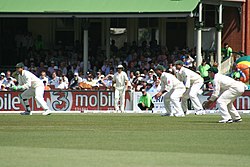Wicket-keeper

In cricket, the wicket-keeper (sometimes called the keeper) is a player in the fielding team. The keeper's job is to guard the wicket which the batter is defending. Law 27 of The Laws of Cricket sets out the rules that apply to the wicket-keeper.[1] The wicket-keeper is the only member of the fielding team permitted to wear gloves or external leg pads. The pads are the same as those worn by a batter, but the gloves are a different type, and Law 27 limits the amount of webbing they may have.[1] The wicket-keeper must not distract or obstruct the batter.
Law 27 also outlines the rules which apply to the keeper's position on the field, and to the movements the player is allowed to make. Essentially, the keeper must remain behind the wicket until the ball reaches the batter or passes the wicket. The keeper can move, within certain limits, before the ball reaches the batter. For example, it is okay to move sideways if the ball is going past the stumps. One of the keeper's main tasks is to prevent byes, and he/she has to be in position to intercept a ball which passes the stumps as byes are extras in the batting team's total.[1]
Wicket-keeper Media
Wicket-keeper in characteristic partial squatting position (together with slip fielders), facing a delivery from a fast bowler.
Adam Gilchrist of Australia standing up to the stumps against England during the fourth test of the 2005 Ashes series in England.
Affie Jarvis in wicket-keeping equipment, c. 1897
References
- ↑ 1.0 1.1 1.2 "Law 27. The Wicket-keeper". The Laws of Cricket. Marylebone Cricket Club. 2017. Retrieved 2 July 2025.




